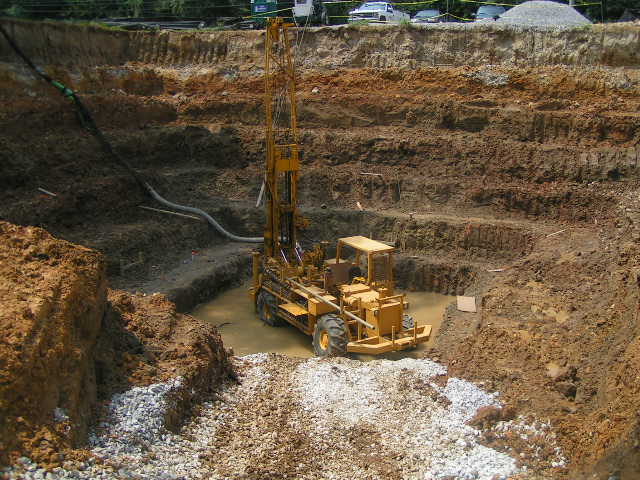Geotechnical Geologist Services for Accurate Dirt and Rock Evaluation
Geotechnical Geologist Services for Accurate Dirt and Rock Evaluation
Blog Article
How Consulting Engineers Enhance Geotechnical Design Projects: Insights Into Their Proficiency, Techniques, and Collaborative Approaches
Consulting designers are crucial in improving geotechnical design projects, applying their specialized knowledge to navigate the complexities of subsurface problems. Their collective strategies foster communication among diverse project stakeholders, eventually shaping the job's trajectory.
Duty of Consulting Engineers
The competence of seeking advice from designers in geotechnical engineering is fundamental to the successful execution of building and construction jobs. These experts play a pivotal role in analyzing soil and rock residential or commercial properties, which are critical aspects affecting style and building and construction decisions. By conducting complete website investigations, getting in touch with engineers collect essential data that notifies the layout procedure, making sure projects are developed on stable and suitable ground.
Consulting designers likewise supply very useful insights right into danger administration (geotechnical geologist). They identify possible geotechnical risks, such as landslides, dirt liquefaction, and negotiation problems, making it possible for stakeholders to execute reliable reduction strategies. Their competence help in enhancing foundation designs, which can cause considerable cost savings and boosted safety and security
Additionally, consulting engineers act as an essential web link in between project owners, designers, and service providers. Their capacity to translate intricate geotechnical information right into actionable suggestions fosters collaboration and facilitates notified decision-making throughout the task lifecycle. This multidisciplinary method not only improves task efficiency however additionally makes sure conformity with regulatory requirements and best techniques.
Key Methods in Geotechnical Design

One key method is site examination, which includes performing area tests and lab evaluations to gather information on subsurface conditions. Methods such as Requirement Infiltration Screening (SPT) and Cone Infiltration Testing (CPT) are widely utilized to examine dirt stratigraphy and toughness. In addition, geophysical methods, consisting of seismic and electrical resistivity surveys, provide non-invasive methods to assess subsurface attributes.
One more critical method is mathematical modeling, which makes it possible for engineers to simulate numerous circumstances and forecast just how soil-structure communications will certainly act under various loading conditions. Limited Component Evaluation (FEA) is a typical method used in this context.
Moreover, the design of structures, keeping structures, and earthworks relies heavily on these techniques - geotechnical geologist. By integrating sophisticated logical devices with field data, seeking advice from engineers can establish customized remedies that resolve particular project obstacles, eventually adding to the security and security of construction projects
Value of Dirt Evaluation
Soil analysis works as a foundational element in geotechnical engineering, supplying vital insights right into the physical and chemical homes of dirt required for reliable building planning. Comprehending soil qualities is crucial for establishing its load-bearing capability, drain actions, and capacity for negotiation or instability. Thorough dirt examinations, including tasting and research laboratory screening, find this aid determine specifications such as soil kind, dampness content, density, and shear strength.
These evaluations inform the option of proper building methods and products, eventually influencing job safety and longevity. For example, natural soils may call for various foundation layouts contrasted to granular dirts, necessitating customized engineering solutions. In addition, dirt analysis help in determining pollutants that might position risks to human health or the setting, permitting the growth of reduction strategies.
Incorporating dirt evaluation right into the very early stages of task development assists to reduce unforeseen difficulties, ensuring that engineers can prepare for and attend to potential issues prior to they escalate. By developing a comprehensive understanding of the website conditions, seeking advice from engineers can optimize resource style effectiveness and minimize costs, thus improving the overall success of geotechnical design jobs.
Collective Techniques in Jobs
Successful geotechnical jobs frequently depend upon collective strategies that unite diverse proficiency from different disciplines. Reliable partnership amongst seeking advice from designers, geologists, environmental scientists, and construction specialists is crucial for resolving complicated difficulties and enhancing project end results. By leveraging the special abilities and expertise of each team member, jobs can benefit from a holistic understanding of the website problems, regulative requirements, and design constraints.
Regular interaction and interdisciplinary meetings help with the sharing of understandings and foster a society of synergy. These joint efforts make it possible for the identification of possible threats early in the task lifecycle, permitting timely mitigation methods. Incorporating responses from stakeholders, consisting of neighborhood neighborhoods and regulatory agencies, makes certain that all viewpoints are considered, improving job approval and compliance.
Furthermore, the combination of innovative technologies, such as Geographic Details Solution (GIS) and Structure Information Modeling (BIM), more improves partnership. These devices enable the real-time sharing of information and visualization of geotechnical conditions, promoting educated decision-making. Ultimately, a collaborative technique not just streamlines task execution but additionally lays the structure for cutting-edge options to complex geotechnical engineering difficulties.
Effect On Project Results

Consulting designers utilize innovative approaches such as danger evaluation and anticipating modeling, which improve the accuracy of task forecasts. Their ability to integrate innovative modern technologies, like geotechnical instrumentation and information analytics, additionally improves the style and building and construction procedures. Therefore, projects experience enhanced efficiency, lowered expenses, and minimized delays.
Furthermore, cultivating reliable communication and partnership among team members boosts analytic abilities. When difficulties emerge, a joined front permits for speedy identification of services, preventing potential problems. Ultimately, the collaborative efforts of speaking with designers contribute to higher high quality end results, guaranteeing that projects satisfy both regulatory standards and client assumptions.
Final Thought

Report this page